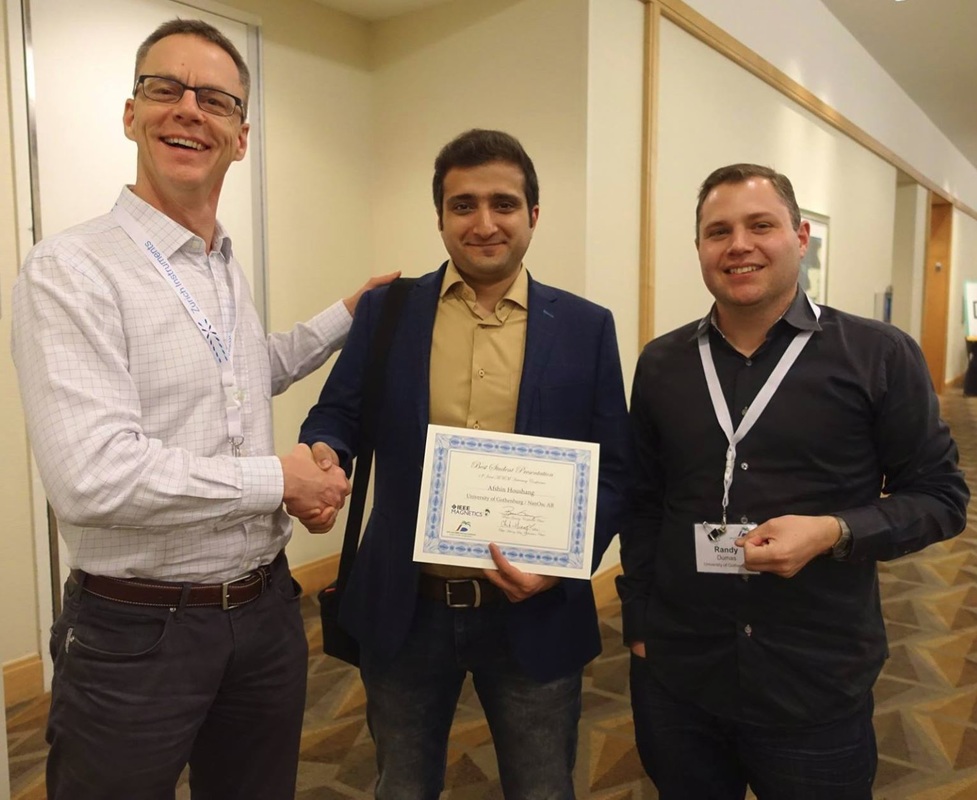|
0 Comments
 Congratulations to Afshin Houshang, Ezio Iacocca, Philipp Dürrenfeld, Sohrab Sani, and Randy Dumas! Spin wave beams can now be generated and controlled using spin transfer torque. Here those beams finally solve how to synchronize a record number of spin-torque oscillators. We basically see no limitations to how many additional oscillators we can daisy chain together and synchronizae. They can also be applied in a number of other ways, e.g. in neuromorphic devices and computing. You can read the paper in Nature Nanotechnology here: Spin-wave-beam driven synchronization of nanocontact spin-torque oscillators A number of blogs and journals have highlighted our work: Researchers at the University of Gothenburg create focused spin wave beams - synchronize an unlimited number of spintronic oscillators.
 The group enjoying tasty Iranian food at Shiraz in Gothenburg to send Mojtaba off to University of California, Riverside. It's been 2+ very busy years. In addition to all the research work, we are particularly grateful for Mojtaba's crucial contributions to making Magnonics 2013 and our smaller local workshops such successes. Best of luck developing spin wave electronics at UCR!
 Anna-Karin Tornberg, Johan Åkerman, Per Hammarström, Emmanuelle Charpentier, and Fredrik Bäckhed, after having received the Göran Gustafsson Prize 2014 from the hands of His Majesty The King. Some more information in Swedish: Göran Gustafssonprisen hör till de mest eftertraktade och prestigefyllda prisen bland yngre svenska forskare. Årets fem pristagare delar på nästan 24 miljoner kronor och belönas för sin forskning om numeriska beräkningsalgoritmer, mikrovågor på nanonivå, misslyckade och felveckade proteiner, mekansimer som styr bakteriell immunitet samt tarmflorans betydelse för sjukdomar såsom diabetes.
Priserna utdelas årligen sedan 1991 inom områdena matematik, fysik, kemi, molekylärbiologi och medicin av Göran Gustafssons stiftelse för naturvetenskaplig och medicinsk forskning. Prisnomineringar kommer från landets universitet och högskolor och bereds av Kungl. Vetenskapsakademien, som också överlämnar prisen. Stiftelsen förvaltar ett kapital om cirka en miljard kronor.  Today we congratulate Ezio for being selected as one of five finalists for the Best Student Presentation Award of Intermag 2014! Ezio will present his recent work "Fine-tuning the energy landscape of localized spin wave modes in elliptical nanocontact spin torque oscillators". During the conference, a panel of experts in magnetism will view and judge each finalist's presentation. The panel will select one winner based on the following criteria: (1) The quality and impact of the work; (2) The student contribution and involvement in the work; (3) The quality of the presentation by the student. The Awards and Plenary Session which will be held at the conference at 4:00 pm on May 7 (Wednesday). All the finalists will be honored in this session. The winner will receive an award of $1000, and each remaining finalist will receive an award of $250. Celebrating the publication of Ezio's Phys. Rev. Lett., 112, 047201 (2014). Happy times and very tasty burgers at Butcher's Market! From left to right: Afshin, Randy, Johan, Yuli, Ezio, Masoumeh and Philipp.
 This analytical and numerical work builds on our previous experimental demonstration of magnetic droplet solitons [Science 339, 1295 (2013)] where we confirmed the predictions by Ivanov and Kosevich from over 35 years ago [Zh. Eksp. Teor. Fiz. 72, 2000 (1977)] and the more recent predictions by Hoefer, Silva and Keller [Phys. Rev. B 82, 054432 (2010)]. Droplets form naturally in systems with attractive forces. Water droplets are e.g. formed from the attractive polar interactions between water molecules. In ultrathin magnetic films the so-called perpendicular magnetic anisotropy (PMA) can create an attraction between spin wave excitations (magnons) and if a sufficient number of magnons are present in a region (analogous to a sufficient number of water molecules) they can condense into a magnetic droplet soliton. Much like water on extended surfaces, droplets are easily formed in extended PMA layers. However, the nucleation in a narrow channel is not easily predicted. In this paper, we show by numerical simulations that magnetic droplets can indeed be excited in nanowires and in doing so can acquire two novel forms: an edge and a quasi-one-dimensional (Q1D) nanowire mode. The edge mode arises as the physical boundaries attract the droplet the same way as a water drop would be attracted by a neighboring polar surface, e.g. a piece of glass. On the other hand, the Q1D exists in very narrow wires, where both boundaries attract the droplet. As a result, the Q1D acquires an additional property known as chirality which is a well-defined magnetic state that makes it especially resistant to disturbances. Due to these characteristics, such novel droplet modes can be identified by their intrinsically different frequency. Our simulations suggest means to experimentally prepare and observe these modes for their detailed physical study and in the prospect of nanoscopic applications for data storage. E. Iacocca, R.K. Dumas, L. Bookman, S.M. Mohseni, S. Chung, M. Hoefer, and J. Åkerman, Con fined dissipative droplet solitons in spin-valve nanowires with perpendicular magnetic anisotropy, Phys. Rev. Lett. 112, 047201 (2014). |
Archives
January 2016
Categories
All
|







 RSS Feed
RSS Feed